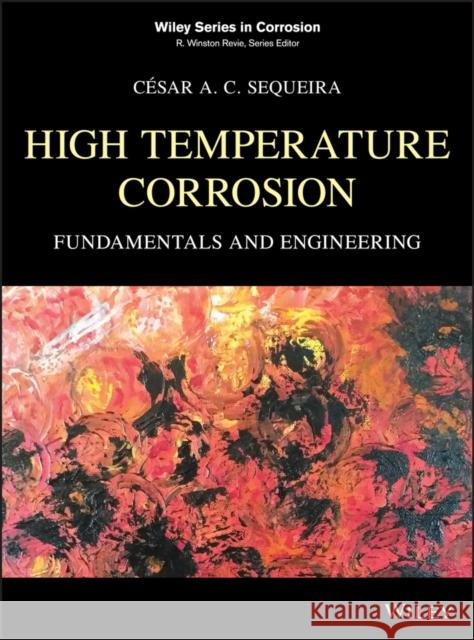High Temperature Corrosion: Fundamentals and Engineering » książka



High Temperature Corrosion: Fundamentals and Engineering
ISBN-13: 9780470119884 / Angielski / Twarda / 2019 / 656 str.
High Temperature Corrosion: Fundamentals and Engineering
ISBN-13: 9780470119884 / Angielski / Twarda / 2019 / 656 str.
(netto: 755,44 VAT: 5%)
Najniższa cena z 30 dni: 786,70
ok. 30 dni roboczych
Bez gwarancji dostawy przed świętami
Darmowa dostawa!
High–temperature corrosion is a widespread problem in a number of industries. Providing engineering data to help users make informed decisions on materials selection, High Temperature Corrosion provides a balanced collection of fundamental and engineering knowledge about key aspects of high–temperature corrosion.
Glosariusz/słownik
Wydanie ilustrowane
Preface xiAcknowledgments xvii1 Introduction 11.1 Definition of High Temperature Corrosion 11.2 Historical Development 11.3 High Temperature Corrosion Phenomena 31.4 High Temperature Materials 31.5 Corrosive Environments 271.6 Films and Scales 311.7 Academic Impact of High Temperature Corrosion 331.8 Industrial Impact of High Temperature Corrosion 381.9 Questions 46References 46Further Reading 472 Metallurgical Structure and Metals 482.1 Imperfections in an Essentially Perfect Structure 482.2 Solidification 562.3 Alloys 622.4 Iron and Steel 722.5 Deformation and Recrystallization 792.6 Fracture and Fatigue 912.7 Questions and Problems 97References 98Further Reading 993 High Temperature Equilibria 1003.1 Introduction 1003.2 Thermochemical Analysis 1003.3 Electrochemical Analysis 119References 128Further Reading 1294 Lattice Defects in Metal Compounds 1304.1 Introduction 1304.2 Defect Reactions 1334.3 Defect Equilibria 1354.4 Equilibrium Constants 1414.5 Questions 144References 144Further Reading 1455 Diffusion in Solid-State Systems 1465.1 Introduction 1465.2 General Theory of Diffusion 1465.3 Diffusion Coefficients 1505.4 Matano-Boltzmann Analysis 1535.5 Kirkendall Effect 1545.6 Darken Analysis 1555.7 Factors Influencing Diffusion 1565.8 Impurity Diffusion in Metals 1585.9 Grain Boundary Diffusion in Metals 1585.10 Diffusion in Solid Oxides 1605.11 Morphology of Reaction Products 1635.12 Measurement of Diffusion Parameters 1645.13 Questions and Problems 168References 168Further Reading 1696 High Temperature Electrochemistry 1716.1 Introduction 1716.2 Electrochemical Nature of Molten Salt Corrosion 1716.3 The Single Potential of an Electrode 1726.4 Equilibrium Diagrams 1736.5 The Tafel Relationship 1736.6 Corrosion Potential-pO2.Relationship 1756.7 Electrochemical Polarization and Monitoring 1776.8 Electrochemical Nature of Metal Oxidation 1796.9 Usefulness of Electrochemical Cells 1816.10 Current-Potential Measurements on Solid Electrodes 1826.11 Simple Concepts of Oxide Semiconductors 1836.12 Conduction Processes in Ionic Oxides 1866.13 Common Solid-State Electrochemical Situations 190References 194Further Reading 1957 Oxidation 1967.1 Introduction 1967.2 Thermodynamic Considerations 1977.3 Kinetic Considerations 1997.4 Defect Structures 2017.5 Compact Scale Growth 2087.6 Multilayered Scale Growth 2127.7 Oxidation Resistance 2147.8 Oxidation of Engineering Materials 2247.9 Conclusions 2287.10 Questions 229References 229Further Reading 2318 Sulfidation 2338.1 Introduction 2338.2 The Process of Sulfidation 2338.3 Sulfidation Kinetics 2358.4 Sulfidation of Selected Materials 2368.5 Defect Structures of Metal Sulfides 2408.6 Questions 243References 243Further Reading 2449 Carburization and Metal Dusting 2459.1 Introduction 2459.2 Carburization 2459.3 Alloy Resistance to Carburization 2519.4 Metal Dusting Problem 2559.5 Metal Dusting Mechanisms 2569.6 Alloy Resistance to Metal Dusting 260References 262Further Reading 26310 Nitridation 26410.1 Introduction 26410.2 Nitridation Mechanisms 26410.3 Nitridation in Industrial Media 26510.4 Questions and Problems 273References 274Further Reading 27511 Halogenation 27611.1 Introduction 27611.2 Metal-Halogen Reactions 27711.3 Alloy-Halogen Reactions 27911.4 Laboratory Studies 28011.5 Conclusions 28211.6 Questions 282References 282Further Reading 28312 Corrosion by Hydrogen and Water Vapor 28412.1 Introduction 28412.2 Corrosion by Hydrogen 28412.3 Corrosion by Water Vapor 29012.4 Conclusions 293References 294Further Reading 29513 Corrosion in Molten Salts 29613.1 Introduction 29613.2 Corrosion Process 29613.3 Thermodynamic Diagrams 29813.4 Corrosion Rate Measurements 29913.5 Test Methods 29913.6 Fluorides 30313.7 Chlorides 30413.8 Nitrates/nitrites 30513.9 Hydroxides 30913.10 Carbonates 30913.11 Vanadates 31213.12 Sulfates 31413.13 Prevention of Molten Salt Corrosion 32113.14 Summary 321References 322Further Reading 32414 Corrosion in Molten Metals 32514.1 Introduction 32514.2 Corrosive Processes 32614.3 Industrial Liquid Metals 33214.4 Conclusions 338References 339Further Reading 33915 Hot Corrosion 34015.1 Introduction 34015.2 Engine Description and Materials 34015.3 Early Studies 34115.4 Mechanisms of Hot Corrosion 34915.5 Hot Corrosion of Gas Turbine Alloys 35115.6 Methods of Evaluating Hot Corrosion 35415.7 Prevention of Corrosion 35615.8 Conclusions 35815.9 Questions 358References 359Further Reading 36016 Fireside Corrosion 36116.1 Introduction 36116.2 Coal-Fired Boilers 36216.3 Coal-ash Corrosion 37116.4 Oil-Fired Boilers 37316.5 Corrosion in Waste Incinerators 37916.6 Plant Experience with Fireside Corrosion 38016.7 Conclusions 388References 389Further Reading 38917 Testing and Evaluation 39117.1 Introduction 39117.2 Testing Equipment and Monitoring 39217.3 Optical Microscopy 39417.4 Thermogravimetry 39517.5 Spectroscopy 39817.6 Diffraction Techniques 40217.7 Electron Microscopy 40917.8 Electron Spectroscopy and Ion Scattering 41617.9 Surface Microscopy 42417.10 Optical Spectroscopy 42817.11 Nondestructive Inspection Techniques 43917.12 Traditional Electrochemical Methods 44517.13 Nontraditional Electrochemical Methods 45317.14 Combined Electrochemical Methods 459References 472Further Reading 47518 Protective Coatings 47718.1 Introduction 47718.2 Coating Systems 47718.3 Coating Processes 48018.4 Coating Degradation 49618.5 Summary and Future Trends 49918.6 Questions 500References 500Further Reading 50119 Examples of Engineering Importance 50219.1 Introduction 50219.2 Molten Carbonate Fuel Cells 50419.3 Solid Oxide Fuel Cells 51619.4 Direct Carbon Fuel Cells 52419.5 Nuclear Power Plants 531References 546Further Reading 54920 Case Studies 55120.1 Making Stainless Steels 55120.2 Corrosion Protection of Turbine Blades 55120.3 Oxidation of Silicides for VLSI Applications 55620.4 Naphthenic Acid Corrosion in Petrochemical Plants 56020.5 Oxidation of Ceramic Matrix Composites 56220.6 Shell Corrosion of Rotary Cement Kilns 56320.7 Corrosion of Steels in a Linear alpha Olefin Plant 564References 565Further Reading 565Appendix A 566List of Acronyms 591Glossary of Selected Terms Used in High Temperature Corrosion 596Author Index 615Subject Index 629
CÉSAR A. C. SEQUEIRA, PHD, has been a member of the faculty staff of Instituto Superior Técnico (Univ. of Lisbon), maintaining his academic career in fundamental and technological electrochemistry for more than 40 years. He is the author/co-author of over 250 professional papers, 500 scientific communications, 20 book chapters, and 12 books in the areas of corrosion science and technology, electrochemistry, and materials science. He has directed numerous workshops, including three on Microbial Corrosion of the European Federation of Corrosion. He is a Fellow of the Royal Society of Chemistry (U.K.) and of the Institute of Materials (U.K.), and is an Active Member of the Electrochemical Society. Currently, he is the Senior Research Leader on Electrochemistry of Materials at CeFEMA (Center of Physics and Engineering of Advanced Materials) in Lisbon.
1997-2025 DolnySlask.com Agencja Internetowa
KrainaKsiazek.PL - Księgarnia Internetowa









